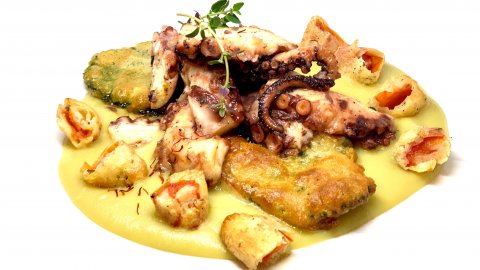Of medium-small size and with a dimple in the lower part, the Carpino bean, tender and tasty, has the characteristic of appearing green at the time of harvesting and become, over time, sand-white. Its particular flavor comes from calcareous and clayey soils of the area, perfect for growing broad beans. We are in the heart of the Gargano National Park and the Gargano mountain community, in the province of Foggia.
It is thanks to the nature of the soil that an excellent quality oil is produced in Carpino and broad beans have been cultivated since time immemorial.
Its historic center is a true jewel of architecture. The houses seem to lean one on top of the other and the streets are small alleys interspersed with stairways, flanked by characteristic balconies called "Mugnal", original galleried balconies which were used not only to access the first floors but also to spend a little outdoor time. And one can imagine that once upon a time the women waited in these poor houses to cook the broad beans in terracotta pots on the fire, which would have represented the basic meal for the peasants who returned in the evening from working in the fields.
Humble but very tasty broad beans planted in rotation with durum wheat, sugar beets, tomatoes and lupins. Sowing takes place in the months of October and November. They are not fertilized or treated: weeds are removed by hand. Between June and July, when the plants have turned yellow, they are cut by hand and tied into sheaves (the so-called manocchi) which are left to dry in the field. In the meantime, a circular area (arij) is prepared by wetting the ground, covering it with straw and compacting it.
The aim is to create a hard and compact layer on which to work. In the month of July, when the manocchi are well dried, they are placed on the arij (after having removed the straw) and, when the sun is high, we move on to the weighing phase: a farmer stands in the center of the area, while a or more horses go round crushing the sheaves. Then, with traditional wooden forks, the beans are separated from the straw. Finally, to eliminate even the smallest particles, they are lifted with wooden shovels and thrown into the air, taking advantage of the afternoon breeze.
As with so many other testimonies of the great heritage of biodiversity that enriches the gastronomic history of our country, the humble but tasty Carpino beans had set off, giving way to more profitable productions, on the road to oblivion. Fortunately they have been included among the Slow Food Presidia and this has meant that they have been given greater commercial attention which has ensured their survival.
Salvatore Riontino, patron and chef of the “Canneto Beach 2” restaurant scenically located between the expanses of sand and salt of the beautiful sea of Margherita di Savoia, in 50 years of work he has brought his cuisine to levels of great depth. A kitchen that moves on two tracks, a fresh fish that arrives every morning from faithful and trusted suppliers, as it is difficult to taste in the area, and strictly local raw materials that the Chef procures by personally looking for them in the countryside of the hinterland. The old trattoria is now an elegant restaurant with an excellent choice of local and national wine labels but this has not changed the chef's loyalty to his land in any way
The dishes of the Apulian tradition here acquire true sincerity and are remembered, with touches of creativity that enhance their flavor even more. Carpino broad beans, obviously, could not be missing from his menu based on the treasures of this land so generous in taste.
The recipe: Hornbeam broad bean puree with Cuor di Saffrano with roasted octopus and fried borage
Ingredients for 4 people
For the hornbeam beans
dried broad beans 500 g
onions2 pcs
bay leaves2
2 carrots
1 celery
1 potato
Extra Virgin Olive Oil 200 g
sale
Heart of saffron half a gram
For the octopus
Octopus 600 g
fresh thyme 20 g
Coratina Extra Virgin Olive Oil
salt and pepper
For the sage cherry tomato
borage 8 leaves 16 cherry tomatoes
Maizena Corn starch 700 Gr
Seed oil for frying
Method for the octopus
Fresh matured or defrosted octopus
Cook in water for about 1 hour on a low flame
Check when ready cut the tentacles in 2 and grill. Marinate with its water with lemon salt and thyme
Process for broad beans
Soak the beans at least 12 hours before cooking.
Boil them in a 2 liter saucepan of water, remove the foam and drizzle with the Coratina extra virgin olive oil. In a saucepan put the bay leaf and chopped onion, potato, celery and carrot and cook over low heat. Blend with the immersion blender by pouring and adding the saffron already soaked.
Procedure for the borage and cherry tomato
Pass the borage and the tomato in the cornstarch and fry in boiling seed oil.
Introduction
Serve the broad beans with saffron heart at the base of the plate with a steel ring. Layer the roasted octopus and decorate with the fried borage and breaded tomatoes
Canneto Beach 2 restaurant
Via Garibaldi, 147,
76016 Margherita of Savoy BT





